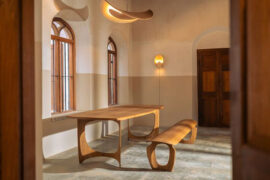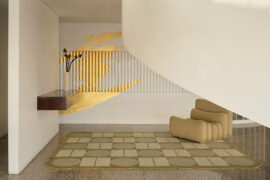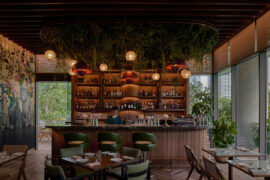Naoto Fukasawa outfits a traditional michiya into Issey Miyake’s first standalone store in Kyoto, offering a tranquil backdrop for the brand’s graphic and colourful clothing.
May 15th, 2018
Fashion design house Issey Miyake is known for its avant-garde, technology driven garments, particularly for its clothing range made from the processes of pleating and heating that allow metamorphosis of form, flexibility of motion, and ease of care. However, its new standalone store in Kyoto, housed in a 132-year-old traditional Japanese michiya (townhouse) with gently waving grey roof tiles and timber-latticed facade, speaks more of tradition than progressiveness.
But such juxtaposition makes the encounter all the more unique. After all, history forms the basis of new invention. Designed by Naoto Fukasawa, the interior is awash in a mix of charcoal grey plaster, created by mixing black sumi pigment into the plaster, in order to create an ambience of sophisticated calm. Much trial and error was conducted with Kyoto artisans to create the ideal grey-scale colour balance.
The front of the two-storey main building contains the retail space, where the interior’s inky floor and walls form a neutral foil to the brand’s colourful clothing and bags. Much of the existing timber structure was retained, with some new components added for reinforcement and the slant of the originally steep staircase adjusted for customers’ comfort.
At the back of the store through large picture-frame windows, customers are beckoned to a smaller building, accessed by treading over ashen tiles in a sea of pebbles. Here, customers are invited to an extended experience in a gallery, where changing exhibitions showcase Japanese traditional craftsmanship, culture and Issey Miyake’s clothing research.
This standalone structure used to be the kura (storehouse) of the michiya. Formerly two storeys, the floors of the second storey were removed to create a lofty interior, which is well suited as an exhibition space. When the shop opened in March this year, Issey Miyake’s third series of its Ikko Tanaka Issey Miyake collection was being showcased. Its bright, saturated colours hung on mannequins and on the wall as prints contrasted with the white walls and cement flooring, framed by traditional two-panel doors.
While a louder intervention would have reflected the brand more outwardly, this more subtle approach fittingly reflects its locale. Fukasawa’s intention was to create a tranquil space where customers can feel the spirit and layers of time that the building has lived through, rather than distract from this encounter with a more adventurous design.
Find out what designers can learn from Issey Miyake.
–
Want more stories like this straight to your inbox? Sign up for our newsletter.
INDESIGN is on instagram
Follow @indesignlive
A searchable and comprehensive guide for specifying leading products and their suppliers
Keep up to date with the latest and greatest from our industry BFF's!

London-based design duo Raw Edges have joined forces with Established & Sons and Tongue & Groove to introduce Wall to Wall – a hand-stained, “living collection” that transforms parquet flooring into a canvas of colour, pattern, and possibility.
The new range features slabs with warm, earthy palettes that lend a sense of organic luxury to every space.

A longstanding partnership turns a historic city into a hub for emerging talent

For Aidan Mawhinney, the secret ingredient to Living Edge’s success “comes down to people, product and place.” As the brand celebrates a significant 25-year milestone, it’s that commitment to authentic, sustainable design – and the people behind it all – that continues to anchor its legacy.

From Australian architects to Spanish and Indian designers, Design Mumbai 2025 expands its international reach — proving India’s growing role on the global design stage.

GEYER VALMONT is launching an innovation hub designed to improve existing interior design capability through enhanced ways of working and industry-leading technology products.

CapitaMall Skyview is a new shopping centre in Chongqing, China designed by CLOU architects and offering a layered interior that mirrors the city’s distinctive urban landscape.

The use of a single colour as the pivotal and defining design strategy, the unconventional application of contemporary colour on heritage projects, and the softening of traditionally ‘hard’ building typologies were observed in the winning projects at the 39th Dulux Colour Awards.
The internet never sleeps! Here's the stuff you might have missed

In the latest collaboration between Designer Rugs and Greg Natale, the raw rigour of modernist geometries finds its most comforting articulation in the inherent softness of floor coverings.

Grounded by the rich warmth of American white oak, The Standard’s newly opened restaurant, Kaya, redefines the classic dining convention through a tasteful fusion of biophilic design, mid-century modern sensibility and elevated whimsy.

Adam Markowitz Design, in collaboration with Simeon Dux, has been awarded The Object at the INDE.Awards 2025. Their winning project, A Cabinet of Curiosities, is a masterwork of craftsmanship and adaptability; a poetic response to shifting domestic and professional life in the post-COVID era.